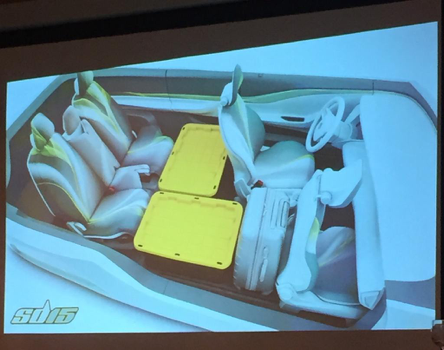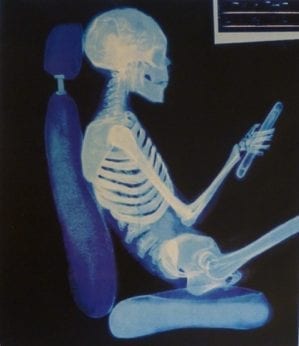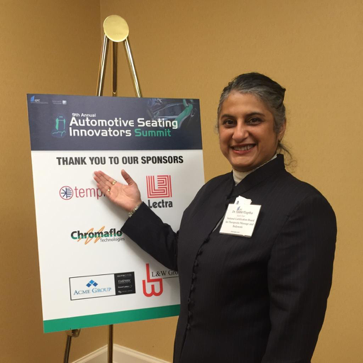By Leena S. Guptha, DO, MBA, BCTMB, PCOM Academic Dean of Graduate Studies
How many minutes per day do you spend driving? Research shows that nearly 180 million of us utilize cars as our primary means of transportation for short trips, long trips, and everything in between. As we have seen over the years, cars come in all shapes, styles, and levels of comfort. What we might be overlooking, however, is how critical the role of the seat may (or may not) play in relation to back pain and discomfort.
Insights from the Automotive Seating Innovators Summit
The 9th Annual Automotive Seating Innovators Summit for Seating Innovators brought together international expertise including automotive engineers, ergonomists, kinesiologists, military design, osteopaths, and massage therapists to discuss some of the following precautions when driving:
- Take breaks: Drive only one hour at a time. If you are taking long trips, schedule a stop for every hour or so to stretch your legs and maintain blood flow.
- Drink plenty of water: Sitting compresses water out from the discs; the more hydrated a disc remains, the healthier it will be—and the greater its ability to absorb shocks.
- Optimal tire pressure matters: Think of tires like a second layer of shock-absorption. The make, model, and condition of the tires impacts not only the driving experience, but also the pelvis and lumbosacral junction—leading to that all-too-familiar stiffness after the drive.
- Avoid potholes and other aggravating road conditions: Each time you hit a pothole or large bump unexpectedly, the jolting motions or vibrations can precipitate or aggravate back pain.
- Keep muscle fatigue in mind: Here, I have to defer to the German engineers at the conference who conducted research on simulated humanoid models, and found that muscle fatigue could occur in as little as 15 seconds to two minutes in a static posture. It happens much quicker than you think!
What is the Ideal Driving Posture?
Simply stated, one size certainly does not fit all. At the Seating Innovators Summit, I attended a very interesting presentation from the US Army that clearly defined all the dynamic issues in terms of height, weight, and stability in 3D models. Additionally, the presenter shared 3D rotating images of a man in the 5th percentile, as well as the 95th percentile, and demonstrated where the spine, pelvis, and legs fall on a given seat—even mapped areas of tension were noted! The presenter (as well as all of us in the audience) considered that, in the future, vehicles may need to come with two design options: one for the tall, and a second for the not-so-tall consumer. In the end, we all agreed that the issues surrounding biomechanics are far more complex when we consider all of these factors, including height, weight, stability, and even driving style. We do not all adopt that perfect symmetrical posture as shown in mannequin road tests. Truthfully, the key to ideal posture rests in the curves of your spine—particularly your lumbar spine—being well-supported in the seat.
How to Properly Support Your Spine
Properly supporting your spine takes active awareness. There will be times, however, where you find yourself in for a long drive. When you find yourself in that situation, take into consideration the following tips to ensure proper spine support:
- Support the small of your back with a pillow (attaching it to the seat itself).
- Tying the pillow in place means it is less likely to slip sideways with the vibration of the roads.
- If you are shorter in stature, make sure it doesn’t rise up too high on your back, or consider using a smaller pillow.
- When seated in position, make sure to compress the pillow down to be right in the small of your back (in the lumbar hollow) only. Then, lean back over it and relax! If the spine is supported without pushing you forward, then you are in an optimal posture.
- Finally, let your stomach muscles be at ease, yet offering gentle support to your posture. This can reduce over-activation of back muscles, providing you a little more tolerance of the static posture of a longer drive.
Are you interested in becoming a certified massage therapist?
Visit the links below to explore our massage therapy programs at a campus near you:
Automotive Seating Summit Lessons, Reflections & Implications for Massage Therapy
As a participant of primarily healthcare conferences, it was so refreshing to see how massage-related interests in the biomechanics of the spine and impact on the musculature are also heavily valued within the automotive and engineering realms. I learned many inspiring things regarding the future of automotive seating, such as:
- Cars of the future can drive themselves; the current considerations are when to return control to the driver.
- Seats of the future can move closer to the dashboard, allowing for more storage space.
- Driver and passenger seats can swivel so that the two parties can view one another.

Throughout the entire conference, there was much discussion on the automation of massage in the seat in terms of pulsation, constant versus intermittent, and the technologies that mimic the Swedish movements of effleurage and petrissage. Global perceptions and expectations of massage were explained, from deep acupressure style in Asian countries to more varied pressure and technique in Europe and North America. I was delighted to discover that driving posture and massage are considered critical factors for the future of automotive seating. Moving forward, there will undoubtedly be many opportunities for massage therapists, doctors, medical experts, engineers, and automotive designers to collaborate and weigh in on future advancements.
This experience shows the fact that massage therapy extends well beyond the scope of the medical and allied health professions. Opportunities such as presenting at the Automotive Seating Innovators Summit represent just the tip of the iceberg for massage therapy to make an impact on other professions in addition to healthcare.
Tell us! What would be the ideal seat be for you?
Leena S. Guptha is the Academic Dean of Graduate Studies at Pacific College of Oriental Medicine and a graduate of the British College of Osteopathic Medicine. Leena’s interests stem from her osteopathic research on the ergonomics of driving and back pain. She has also received advanced education in massage therapy and integrative health and held a variety of academic leadership positions. She is a former president of the American Massage Therapy Association, past Chair of the National Certification Board for Massage and Bodywork, and has nearly three decades of clinical practice. Her life mission is to see holistic therapies integrated into primary care with equal access for all.
Featured Posts:


